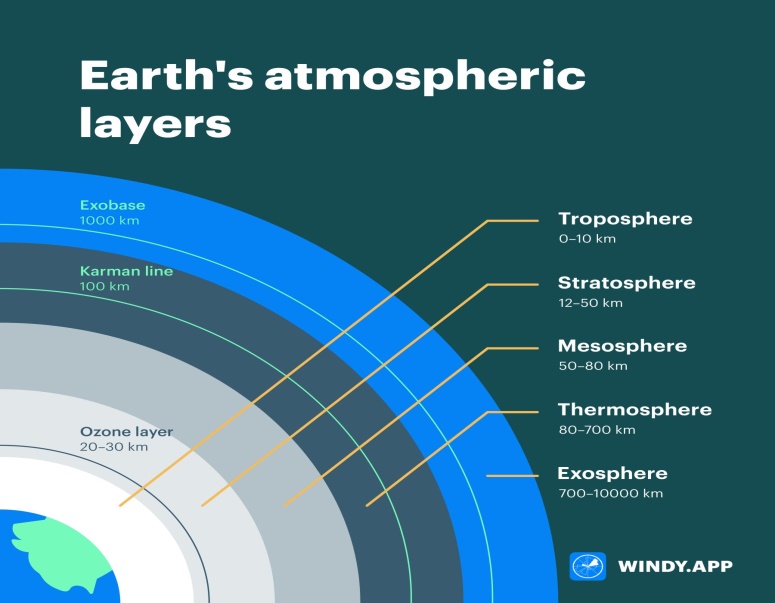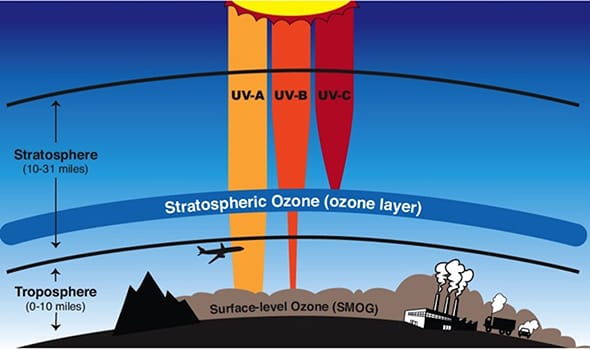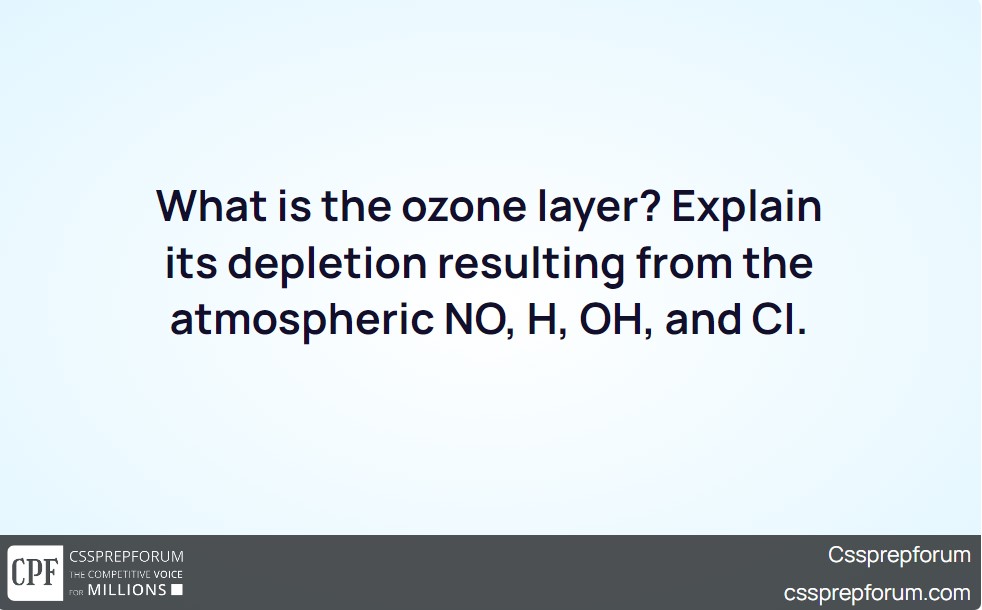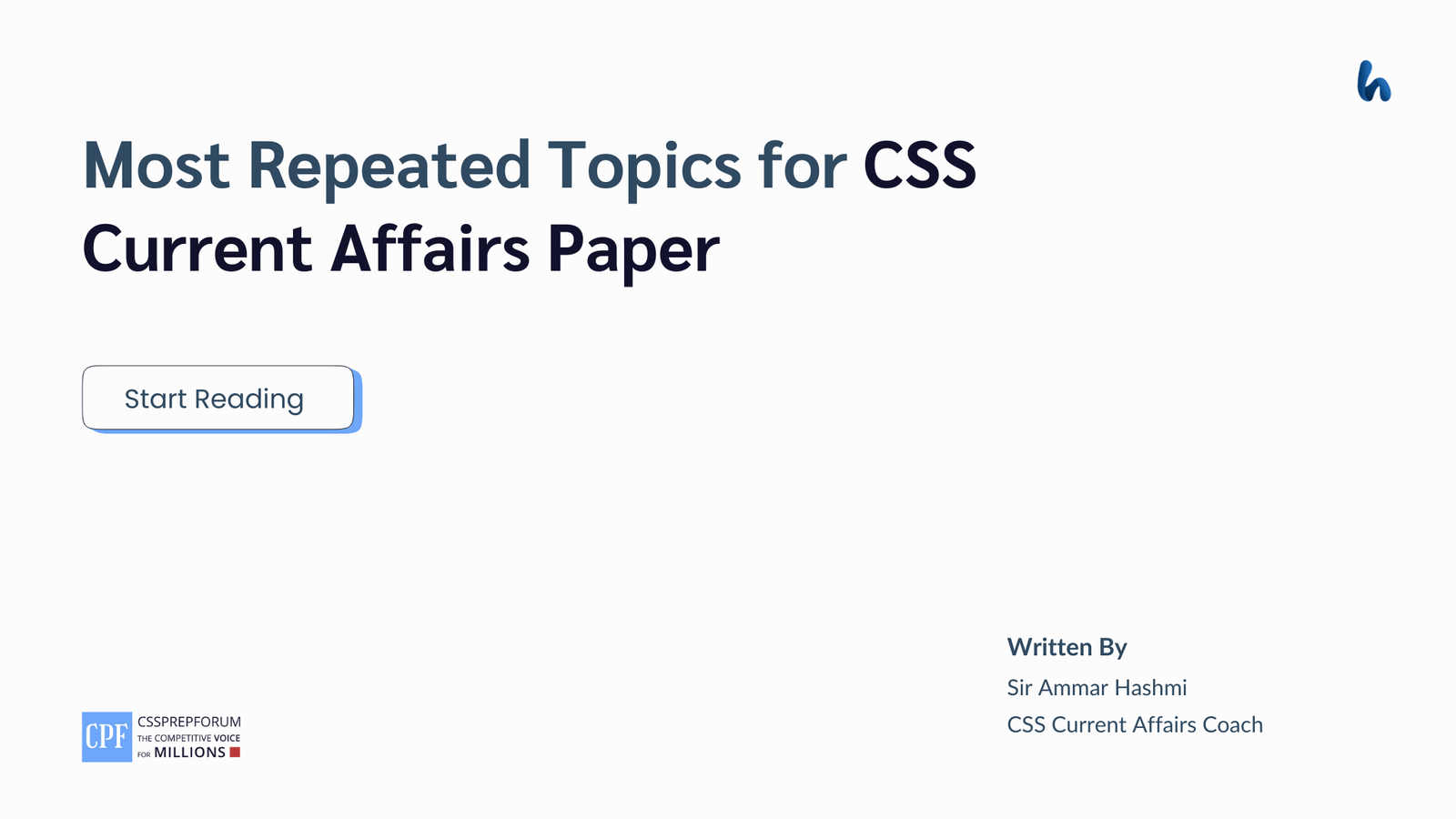CSS Solved Environmental Science Past Paper 2022 | What is the ozone layer? Explain its depletion resulting from the atmospheric NO, H, OH, and CI.
The following question of Environmental Science is attempted on the same pattern, taught by Sir to his students, scoring the highest marks in compulsory subjects for years. This solved past paper question is uploaded to help aspirants understand how to crack a topic or question, how to write relevantly, what coherence is, and how to include and connect ideas, opinions, and suggestions to score the maximum.

Question Breakdown
The examiner expects the following points to be covered in the answer: The definition of the ozone layer and its importance in protecting the Earth from harmful UV radiation. The role of atmospheric NO, H, OH, and Cl in the depletion of the ozone layer. How does each of these pollutants interacts with ozone and contribute to its depletion? Make a comprehensive and convincing outline that covers every relevant aspect of your answer that you are to be covered in your answer. You can make easy and simple diagrams to strengthen your answer. Further, you can validate your answer by providing authentic references from the international community.
Outline
1- Introduction
2- What is Ozone?
- ✓ Good Ozone
- ✓ Bad Ozone
3- Composition of Ozone layer
4- Significance of the Ozone Layer
5- Explanation of Ozone layer depletion with special reference to atmospheric NO, H, OH, and CI
- ✓ Atmospheric NO and its impact on the ozone layer
- ✓ Atmospheric H and its impact on the ozone layer
- ✓ Atmospheric OH and its impact on the ozone layer
- ✓ Atmospheric Cl and its impact on the ozone layer
6- Human activities that contribute to the production of Ozone layer depleting substances
7- Current status of the Ozone layer in the light of the global community
- ✓ UNEP (United Nations Environment Programme)
- ✓ NASA (National Aeronautics and Space Administration)
- ✓ UNFCCC (United Nations Framework Convention on Climate Change)
8- Future recommendations for the protection of the Ozone layer by the International community
9- Conclusion

Answer to the Question
Introduction
The ozone layer is a region of the Earth’s stratosphere that contains high concentrations of ozone molecules. It is an essential component of the Earth’s atmosphere, protecting life on Earth from the harmful effects of the sun’s ultraviolet (UV) radiation. The depletion of the ozone layer has become a major environmental issue, caused by the release of human-made chemicals, including chlorofluorocarbons (CFCs) and other halogenated ozone-depleting substances. However, atmospheric NO, H, OH, and CI also play a role in the depletion of the ozone layer. The depletion of the ozone layer is a critical environmental issue that has long-term consequences for the Earth’s ecosystem and the health of its inhabitants. While the production of human-made chemicals is the primary cause of ozone layer depletion, atmospheric NO, H, OH, and CI are some significant examples of these anthropogenic chemicals. As a global community, it is essential to recognize the severity of the issue and take immediate action to reduce our impact on the environment.
What is Ozone?
Ozone (O3) is a gas that is made up of three oxygen atoms. It is a naturally occurring gas in the Earth’s atmosphere, but it can also be artificially produced through various industrial processes. In terms of its composition, ozone is made up of three oxygen atoms bonded together to form a triatomic molecule. The chemical formula for ozone is O3, indicating that it consists of three oxygen atoms. It is important to note that ozone is a highly reactive gas that can be both beneficial and harmful, depending on where it is found in the atmosphere. Ozone can exist in two forms: “good” ozone and “bad” ozone.
- ✓ Good Ozone
Good ozone, also known as stratospheric ozone, is found in the Earth’s stratosphere, which is located about 10 to 50 kilometers (6 to 30 miles) above the Earth’s surface. This ozone layer plays a crucial role in protecting the Earth from the harmful effects of ultraviolet (UV) radiation from the sun. The ozone layer absorbs most of the UV radiation that would otherwise reach the Earth’s surface, protecting living organisms from the harmful effects of UV radiation, such as skin cancer, cataracts, and immune system damage.
- ✓ Bad Ozone
On the other hand, “bad” ozone, also known as ground-level ozone, is formed near the Earth’s surface when pollutants emitted by cars, power plants, industrial boilers, and other sources react with sunlight. Ground-level ozone is a major component of smog, and it can be harmful to human health, especially for people with respiratory problems such as asthma. Ground-level ozone can also damage crops and other vegetation, and it can harm the environment by contributing to acid rain.

Composition of Ozone layer
The ozone layer is a region in the Earth’s stratosphere that contains a high concentration of ozone (O3) molecules. Its composition consists mainly of ozone molecules, which are formed from oxygen (O2) molecules that are broken down by ultraviolet (UV) radiation from the sun. The composition of the ozone layer is typically expressed in terms of its ozone concentration, which is measured in Dobson units (DU). The average concentration of ozone in the ozone layer is around 300 DU, but it can vary depending on factors such as latitude, altitude, and time of year. In addition to ozone, the ozone layer also contains small amounts of other gases, such as nitrogen (N2), oxygen (O2), and water vapor (H2O). These gases are present in much lower concentrations than ozone and do not play a significant role in the protective function of the ozone layer.

Overall, the composition of the ozone layer is critical for protecting life on Earth from harmful UV radiation, which can cause skin cancer, damage crops and ecosystems, and harm marine life.
Significance of Ozone Layer
The ozone layer is a vital element of the Earth’s atmosphere as it safeguards life from harmful UV radiation from the sun. Its roles include UV protection, climate regulation, ecosystem protection, agricultural benefits, and industrial uses. The ozone layer shields against UV radiation which can cause health problems to absorb some heat from the sun, protecting terrestrial and aquatic ecosystems, and supporting agriculture by preventing damage to crops. Additionally, it is used in industrial applications such as water treatment and air purification. Protecting the ozone layer is critical to ensuring the well-being of the planet and its inhabitants.
Explanation of Ozone layer depletion with special reference to atmospheric NO, H, OH, and CI
Ozone depletion refers to the gradual thinning and reduction of the ozone layer in the Earth’s stratosphere. The main cause of ozone depletion is the release of human-made chemicals known as chlorofluorocarbons (CFCs) into the atmosphere. When CFCs are released, they rise into the stratosphere, where they are broken down by UV radiation, releasing chlorine atoms. These chlorine atoms then react with ozone molecules, breaking them apart and reducing the overall concentration of ozone in the atmosphere. The consequences of ozone depletion can be significant. The depletion of the ozone layer can result in increased levels of UV radiation reaching the Earth’s surface, which can cause skin cancer, cataracts, and other health problems in humans and animals. UV radiation can also damage crops and reduce their yield, harm marine ecosystems, and affect the overall balance of the Earth’s climate.

- ✓ Atmospheric NO and its impact on the ozone layer
NO (Nitric oxide) is produced in the atmosphere through both natural and human activities. It is a gas that plays a crucial role in the chemistry of the troposphere and stratosphere. The main natural sources of NO are lightning and microbial processes in soils, while human activities contribute to a significant increase in NO levels in the atmosphere. NO, reacts with ozone (O3) in the stratosphere, causing the breakdown of the ozone molecule, which is an essential component of the ozone layer. This reaction is known as the NOx catalytic cycle, and it occurs naturally in the atmosphere, but human activities have led to an increase in NOx emissions and, consequently, a higher impact on the ozone layer.
The chemical reaction for the NOx catalytic cycle, where NO reacts with ozone to break down the ozone molecule, can be expressed as follows:
NO + O3 → NO2 + O2
NO2 + O → NO + O2
The overall reaction is:
O3 + O → 2O2
In this reaction, NO acts as a catalyst, meaning it is not consumed in the reaction but instead participates in multiple reaction cycles. The net result of the reaction is the conversion of ozone into oxygen, leading to a depletion of the ozone layer.
- ✓ Atmospheric H and its impact on the ozone layer
Hydrogen (H) is a colourless, odorless, and highly flammable gas. It is the lightest element in the periodic table and makes up about 75% of the elemental mass in the universe. In the atmosphere, hydrogen is primarily produced through the reaction of ultraviolet (UV) radiation from the sun with water vapor in the upper atmosphere, known as the thermosphere. This process is called photodissociation and results in the production of highly reactive hydrogen atoms (H) and hydroxyl radicals (OH). The impact of hydrogen on the ozone layer is complex and depends on the reactions it undergoes. H can either contribute to the destruction of ozone or help to protect it. In the presence of chlorine and bromine molecules, H can react with ozone, breaking it down and depleting the ozone layer. However, H can also react with these same molecules, converting them into less harmful forms that do not deplete the ozone layer. Additionally, H can react with nitrogen oxides (NOx) to form nitric acid, which can enhance ozone depletion. When H reacts with ozone (O3), it can lead to the destruction of ozone through a process called the hydrogen-ozone cycle. This cycle involves a series of reactions between hydrogen atoms, oxygen molecules (O2), and ozone molecules:
H + O3 → OH + O2
OH + O3 → HO2 + O2
HO2 + O → OH + O2
In this cycle, H reacts with ozone to form hydroxyl radicals (OH), which can then react with more ozone to form hydroxyl radicals (HO2). These radicals can then react with oxygen atoms (O) to reform H and OH, and the cycle can repeat. This cycle effectively converts ozone into oxygen molecules and depletes the ozone layer.
However, H can also play a protective role in the ozone layer by reacting with chlorine and bromine molecules that are responsible for ozone depletion. In this case, H can convert these harmful molecules into less harmful forms, preventing them from destroying ozone.
For example
H + ClO → HCl + O
H + BrO → HBr + O
These reactions convert chlorine and bromine molecules into hydrochloric acid (HCl) and hydrogen bromide (HBr), respectively. These molecules are much less reactive to ozone and do not contribute to ozone depletion.
- ✓ Atmospheric OH and its impact on the ozone layer
OH, also known as hydroxyl radical, is a highly reactive and short-lived molecule that consists of one oxygen atom and one hydrogen atom. OH is produced in the atmosphere through various chemical reactions, mainly involving the breakdown of ozone (O3) and the reaction of water vapour (H2O) with excited atomic oxygen (O).OH plays a crucial role in the Earth’s atmospheric chemistry and climate system, including the depletion of the ozone layer. OH reacts with ozone (O3) to form molecular oxygen (O2) and a molecule of oxygen (O), thereby reducing the amount of ozone in the atmosphere. This reaction is essential in the lower atmosphere, where it helps to clean up air pollution and reduce the concentration of harmful gases. However, in the upper atmosphere, where the ozone layer is located, this reaction contributes to the depletion of the ozone layer, which is crucial in protecting the Earth from harmful solar ultraviolet radiation.
OH + O3 → O2 + O2 + OH
In this reaction, OH reacts with ozone (O3) to form molecular oxygen (O2) and a molecule of oxygen (O), which can then react with other molecules to form additional ozone-depleting compounds. This reaction is just one example of the complex chemical processes that occur in the Earth’s atmosphere and contribute to the depletion of the ozone layer.
- ✓ Atmospheric Cl and its impact on the ozone layer
Chlorine atoms and their compounds, known as Chlorine (Cl) containing compounds, respectively, are known as Chlorine, and they are collectively referred to as “Atmospheric CI” or “Ozone Depleting Substances” (ODS). These substances are extremely reactive and can participate in complex chemical reactions in the atmosphere, leading to ozone depletion. Chlorine radicals are highly reactive and can participate in complex chemical reactions in the atmosphere, leading to ozone depletion. Specifically, they react with ozone (O3), breaking it down into oxygen (O2) and other oxygen-containing compounds. The process of ozone depletion leads to the formation of an ozone hole over the Antarctic region, which can have significant environmental and health impacts.
One example of a chemical reaction involving atmospheric CI and the ozone layer is:
Cl + O3 → ClO + O2
In this reaction, a chlorine radical (Cl) reacts with an ozone molecule (O3) to form a chlorine monoxide radical (ClO) and a molecule of oxygen (O2). The chlorine monoxide radical can then participate in further reactions that lead to the depletion of ozone in the atmosphere.

Human activities that contribute to the production of Ozone layer depleting substances
Human activities are responsible for the production of ozone layer-depleting substances, which have a detrimental impact on the Earth’s protective ozone layer. Chlorofluorocarbons (CFCs) and other halogenated compounds are commonly used in refrigeration and air conditioning systems, foam insulation, solvents, and aerosols. These chemicals are long-lasting and can reach the stratosphere, where they contribute to the breakdown of the ozone layer. Additionally, the pesticide methyl bromide is a potent ozone-depleting substance, although its use has been restricted under the Montreal Protocol. Other human activities that contribute to the production of ozone-depleting substances include industrial processes, such as the manufacture of semiconductors and polyurethane foam, and the use of certain types of fire extinguishers. Overall, reducing the use of these substances is crucial to protecting the ozone layer and mitigating the harmful effects of UV radiation on human health and the environment.

Current status of the Ozone layer in the light of the global community
In response to these concerns, the international community has taken steps to reduce the production and use of ozone-depleting substances. The Montreal Protocol, which was signed in 1987, is an international treaty that aims to phase out the production and use of CFCs and other ozone-depleting substances. This treaty has been successful in reducing the concentration of these substances in the atmosphere and slowing the depletion of the ozone layer.
- ✓ UNEP (United Nations Environment Programme)
UNEP (United Nations Environment Programme) released a report in 2018 which stated that the ozone layer is showing signs of recovery and is expected to return to pre-1980 levels by the middle of the 21st century. This is due to the successful implementation of the Montreal Protocol.
- ✓ NASA (National Aeronautics and Space Administration)
NASA (National Aeronautics and Space Administration) has been monitoring the ozone layer for several decades using satellite data. Their recent reports have shown that the size of the ozone hole over Antarctica has been shrinking in recent years due to the successful implementation of the Montreal Protocol. However, they also warn that the ozone layer is still vulnerable to future depletion, and continued monitoring and protection efforts are necessary to ensure its recovery.
- ✓ UNFCCC (United Nations Framework Convention on Climate Change)
UNFCCC (United Nations Framework Convention on Climate Change) has not released any recent reports specifically about the ozone layer, as their focus is primarily on climate change. However, their work is important in addressing the root causes of ozone depletion by reducing greenhouse gas emissions that contribute to climate change.
Future recommendations for the protection of the Ozone layer by the International community
Protecting the ozone layer is crucial as it absorbs harmful ultraviolet radiation from the sun. To achieve this, implementing and enforcing the Montreal Protocol, promoting the use of alternatives, increasing public awareness, supporting scientific research, fostering international cooperation, and addressing emerging issues are recommended. The Montreal Protocol, which aims to phase out the production and consumption of ozone-depleting substances, needs to be enforced to prevent further damage. The use of alternatives to ozone-depleting substances, such as hydrofluorocarbons, should be encouraged. Educating the public about the importance of the ozone layer is crucial, as is supporting scientific research into the impacts of ODSs and alternative technologies. International cooperation is essential to share information, coordinate efforts, and enforcing regulations. It is important to assess emerging technologies and chemicals and their potential impact on the ozone layer. By working together, we can ensure a healthy ozone layer for future generations.
Conclusion
Conclusively, the depletion of the ozone layer is a serious environmental concern that has far-reaching consequences. The reduction in the ozone layer’s protective properties can increase the incidence of skin cancer, cataracts, and other health problems, and it can also harm wildlife and disrupt ecosystems. It is essential to continue international efforts to reduce the production and use of ozone-depleting substances to preserve and protect this vital layer of the Earth’s atmosphere. Through cooperation and ongoing research, we can work towards ensuring a healthy and sustainable planet for generations to come.
CSS Solved Past Papers’ Essays
Looking for the last ten years of CSS and PMS Solved Essays and want to know how Sir Kazim’s students write and score the highest marks in the essays’ papers? Then, click on the CSS Solved Essays to start reading them.
CSS Solved Essays

CSS Solved General Science & Ability Past Papers
Want to read the last ten years’ General Science & Ability Solved Past Papers to learn how to attempt them and to score high? Let’s click on the link below to read them all freely. All past papers have been solved by Miss Iqra Ali & Dr Nishat Baloch, Pakistan’s top CSS GSA coach having the highest score of their students.
General Science & Ability Solved Past Papers
CSS Solved Pakistan Affairs Past Papers
Want to read CSS Pakistan Affairs Solved Past Papers and learn how to attempt them to score high? Let’s click on the link below to read them all freely. All past papers’ questions have been attempted by Sir Kazim’s students, who scored the highest in the subject.
CSS Solved Pakistan Affairs
CSS Solved International Relations’ Past Papers
Have you opted for International Relations in the CSS examination and want to score above 150? Then, click on the CSS Solved International Relations’ Past Papers by Miss Abeera Fatima, the top IR scorer and the best IR coach in Pakistan.
CSS Solved International Relations Past Papers
Articles Might Interest You!
The following are some of the most important articles for CSS and PMS aspirants. Click on any to start reading.












